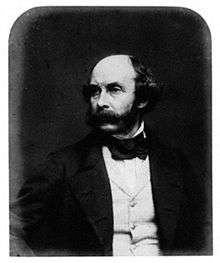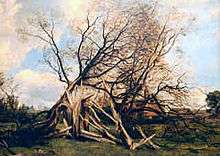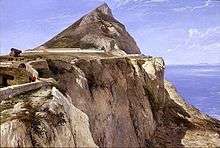Frederick Richard Lee
Frederick Richard Lee RA (10 June 1798 in Barnstaple, Devon – 5 June 1879 in Vleesch Bank, South Africa) was an English artist.
Frederick Richard Lee RA | |
|---|---|
 late 1850s portrait | |
| Born | 10 June 1798 Barnstaple |
| Died | 5 June 1879 (aged 80) South Africs |
| Known for | painter |
Life


Lee was the son of Thomas Lee of Barnstaple in north Devon[1] and brother of Thomas Lee (Jnr), an architect.[2]
Frederick enrolled as a student at the Royal Academy on 16 January 1818, aged nineteen. Although no dated paintings are recorded from this time, by the time of his election as an Associate of the Royal Academy (A.R.A.) on 3 November 1834, at least six dated paintings existed. One of F.R. Lee's paintings from this time is Bringing in the Stag, an oil, measuring 38 cm x 51 cm (1830) at the Tate Gallery in London).[3]
Lee was elected to full membership of the Royal Academy on 10 February 1838. A further seven paintings have been documented as painted by Lee before this date, again as oils, mainly on canvas. The Tate Gallery has an example from this period of his career in Sea Coast Sunrise, which is also painted in oil and is 85 cm x 109 cm (1834).[4] He is known to have produced a further forty dated paintings over the next thirty years. In addition to the dated paintings, fifty undated paintings exist, including Lake in a Park.[5]
Lee had a house at Pilton, near Barnstaple, but being from early life devoted to the sea, he lived a great deal on board his yacht, in which he visited the coasts of France, Spain, and Italy. He exhibited for the last time in 1870, and became an honorary retired academician in the following year. Lee died at Vleesch Bank, Herman station, in the division of Malmsay, South Africa, where some of his family were living, on 5 June 1879.[6]
Career
Lee was a prolific artist, based on the number of oil paintings he is known to have produced, both on canvas and on board. His subject matter choices clearly shared influences with John Constable and other contemporaries. Some of his more notable paintings were done in collaboration with Thomas Sidney Cooper (between 1848 and 1856) and Sir Edwin Landseer, Lee painting the landscape and Cooper and Landseer adding the animals. Landscapes and pastoral scenes form the majority of his painting interest, with some exceptions, for example, Cover Side, The Campfire and Gypsy Tent.
Scottish scenes figured prominently as subjects for Lee, but he also traveled extensively elsewhere in Britain and the continent: Gillingham Mill, Dorset; North Duffield Bridge, Derbyshire; Swiss Bridge, Lynedoch; Fulford Park, Exeter; Ben More looking up Glen Dochart; Shattered Oak in Bedfordshire; Sleaford, Lincolnshire; Rock of Gibraltar; and Pont du Gard, are all examples of this. Lee also spent considerable time at Penshurst, Kent where a number of his paintings originate. His wife Harriet Eves Lee was buried in the churchyard there (at plot 147) after her death in 1850.
Lee's life has been documented elsewhere, and the popularity of his painting remains his lasting legacy. Many of his works have brought substantial prices when sold in recent times. He had a long career with over 90 identified paintings to his credit. However, some recent information has come to light detailing more than 300 of his paintings, suggesting many still reside in private hands or in the unpublished care of museums/National Trust properties. The Constable influence remained throughout his career and he was apparently not tempted to follow the Turner impressionist style, but remained true to his original interests despite the industrial revolution taking place around him.
Lee's paintings were much in demand during his lifetime, and he was certainly not a poor, struggling artist — he appears to have been fairly well-off at the end of his career. Perhaps another aspect to his painting style and prolific output could have been financial. He knew his market, and painted subjects in the style he knew would be popular.
In the last 15 years of his life, Lee divided his time between Broadgate House, his yacht, and South Africa, where he owned several farms. Lee retired on 1 December 1871 and died and was buried near Wellington in South Africa on 5 June 1879. Only three photographic portraits of Frederick Richard Lee have survived, and they can be found in the National Portrait Gallery (London).
Paintings in public collections
Paintings by Lee in public collections are (in chronological order):
| Displayed at | Name | Size | Date |
|---|---|---|---|
| Tate Gallery | Cover Side | 48 cm x 40 cm | 1839 |
| Penrhyn Castle | The River Ogwen at Cochwillan Mill | 1849[7] | |
| Tate Gallery | Evening in the Meadows | 93 cm x 122 cm | 1854 |
| Tate Gallery | A River Scene | 127 cm x 183 cm | 1855 |
| Norwich Castle | Mill on Ogwen River | 25 cm x 35 cm | 1857 |
| de Young Museum, San Francisco | The Overhanging Trees | 84.5 cm x 109.9 cm | 1865 |
| Met Museum | Garibaldi's Residence in Caprera | 87 cm x 138.1 cm | 1865 |
| Museum of Barnstaple and North Devon | The River Taw, and the North Devon Railway | 1868 | |
| Royal Academy | Morning in the Meadows | 112 cm x183cm | 1869 |
| Royal Albert Memorial Museum & Art Gallery | Boys Bathing in a River | about 1823-1870 |
Lee has at least fifty paintings in public collections in the UK.[8]
Notes
- Thomas Lee (1756 — 1836), also son of Thomas Lee of Barnstaple, was a minor architect, the pupil of William Rhodes; he won a silver medal from the Royal Academy in 1776, but soon afterwards retired from London to his native Barnstaple upon inheriting a modest fortune (Howard Colvin, A Biographical Dictionary of British Architects, 1600-1840 3rd ed. [Yale University Press] 1995, s.v. "Thomas Lee".
- Some men who made Barnstaple.., 2010,Pauline Brain
- "Scottish Landscape: Bringing in a Stag (figure and animals by Sir E. Landseer)". Frederick Richard Lee, Sir Edwin Henry Landseer. Tate. Retrieved 17 February 2013.
- "Sea Coast, Sunrise". Frederick Richard Lee. Tate. Retrieved 17 February 2013.
- "Lake in a Park". Frederick Richard Lee. Tate. Retrieved 17 February 2013.
- Cust 1892.
- Penrhyn Castle, Gwynedd, National Trust, 2009 ISBN 978-1-84359-298-3, page 15
- 58 paintings by or after Frederick Richard Lee at the Art UK site
- Attribution
![]()
External links
| Wikimedia Commons has media related to Frederick Richard Lee. |